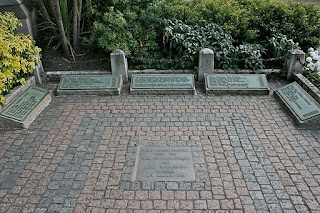If you are
making a short visit to the Peak District of Derbyshire, you could do a lot
worse than make the village of Castleton your centre of operations. Assuming
that you are not an expert caver, but would nevertheless like to get
underground, there are four cave systems within easy reach that are open to the
public, and you also have a splendid castle to visit. Apart from that, this is
an excellent starting point if you are a keen walker, with several strenuous
routes heading off into the hills. One of the walks links all four of the show
caves mentioned below. Castleton is also close to the southern end of the Pennine Way Scotland
Peveril Castle
This is what
gave Castleton its name. The castle stands high on the southern side of the
village, and the approach is via a steep zigzag path that will test your
fitness before you have even started to explore the castle! Peveril Castle Hope Valley
Peak Cavern
This is
approached via a riverside walk that takes you into a gash in the limestone
cliffs, rising to 280 feet, that itself contains the entrance to the cavern.
The cave mouth, the largest natural cave entrance in Britain
Speedwell Cavern
This is not far
from Peak Cavern, but the experience is a very different one. This is only
partly natural, as it is mainly a disused lead mine. It is also very deep, at
600 feet below the surface, although the visitor has only 100 damp steps to
descend (and then climb back up afterwards!). At the foot of the steps you
climb aboard a boat and are taken along an underground canal through a narrow tunnel
that was blasted by lead miners in the 1770s for a quarter of a mile. At the
end of the tunnel you emerge into a vast chamber, the roof of which is out of
sight. You can then look down into the “Bottomless Pit”, so called because the
pool at its foot remained at the same level throughout the mine’s history,
despite having 40,000 tons of waste rock dumped into it.
Treak Cliff Cavern
This is both
a natural set of caves and a mine, although it was not lead that was mined here
but the remarkable stone known as “Blue John” (which is not necessarily blue!).
This is a semi-precious mineral, a variety of fluorspar that is coloured by
various hydrocarbon impurities and which is found nowhere in the world but this
small area of the Peak District. This material has long been highly prized for
making into ornaments, jewellery and even vases and bowls, as it can be
polished like marble. It is still being mined, although the quantities now
available are very much less than they once were.
The first
part of the Treak Cliff Cavern was dug by miners, although a number of natural
caves were opened in the process. Further back, the caves are all natural, as
the Blue John seams only go so far. The tour takes about 40 minutes, during
which you will see a pillar of rock that contains a vein of Blue John that
cannot be mined as the pillar keeps the roof up! You will also visit caverns
that contain thousands of stalactites, some of which have been growing for
100,000 years. At one point a stalactite (hanging from the ceiling) is nearly
touching a stalagmite that is growing from the floor. The gap between them is
only an inch and a half; come back in a thousand years’ time and they will have
joined up!
Blue John Cavern
As its name
suggests, this is another Blue John mine, sited about two miles to the west of
Castleton. This is a combination of natural and man-made chambers, notable for
their rock formations and walls coloured by minerals and iron oxide deposits.
At one point a stalactite formation looks like a frozen waterfall, and at
another two streams met and formed a whirlpool that created a roughly circular
chamber. The final chamber has a roof more than 200 feet high. Blue John is
still being produced (in parts of the mine not open to the public) and pieces
can be bought or ordered from the craft shop. If you buy an ornament made from
Blue John it will be unique, because no two pieces are ever identical.
A visit to
the Castleton area is well worth the trip, and a single day will not be enough.
Also, bear in mind that this is only one small part of the Peak District, and
there is a lot more yet to explore.
© John
Welford













